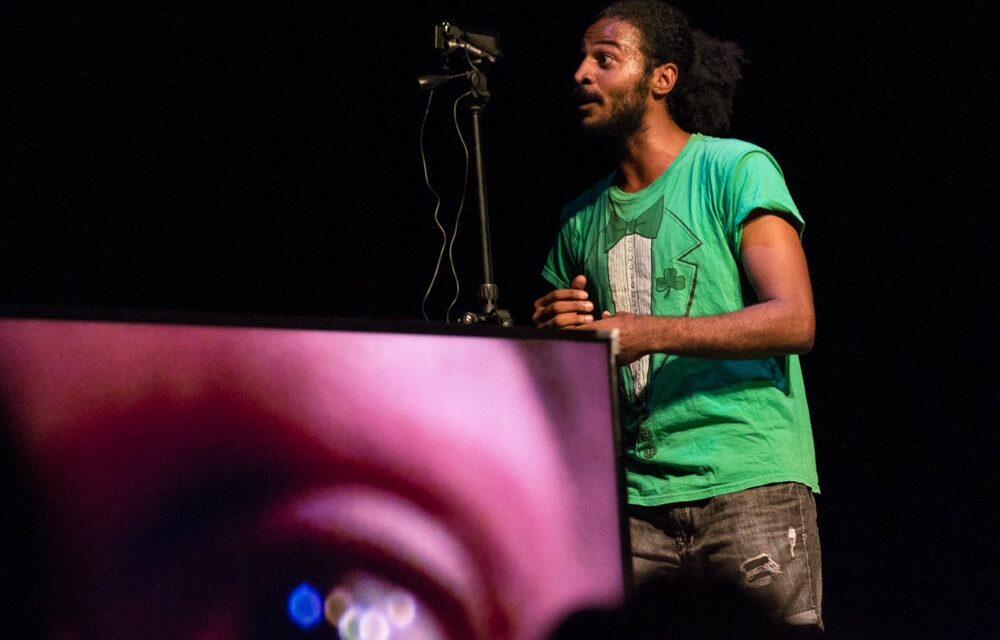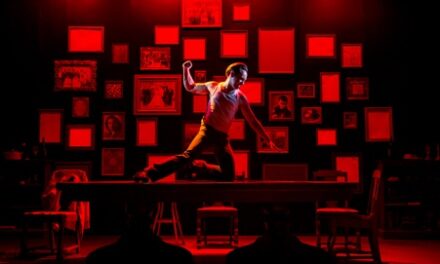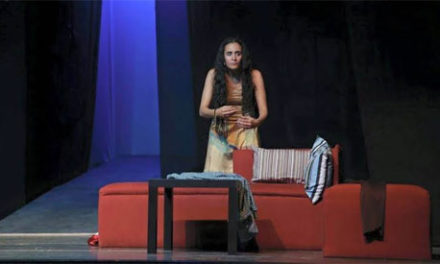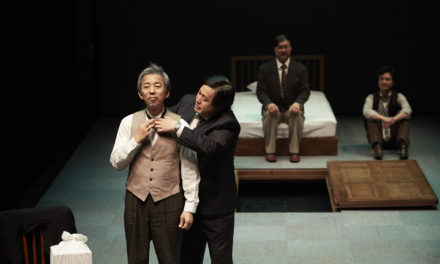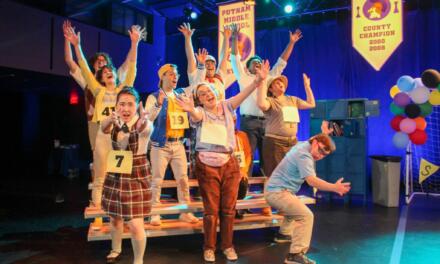Art Babayants, of Armenian origin, has a doctorate in theatre performance, he taught acting in the theatre department of the University of Regina, is a pianist and the artistic director of the Toronto Laboratory Theatre. But those are only a few of his many talents. He was invited by professor Meerzon to bring in his cast who all speak several languages and who are interested in normalizing a linguistic landscape that presents a special form of diversity in the theatre. His work fits in perfectly with a research symposium entitled, Mediating Performance experiences: cultures and technologies in conversation, which took place at the University of Ottawa organized by Dr. Yana Meerzon, a specialist in questions of theatre and immigration in Canada, as well as migration and multilingualism in European Theatre.
This performance by young people, mostly recent immigrants, included guests from Montreal and Ottawa who were integrated into the group, might have sounded overly ambitious for the audience who probably only understood one or two of the languages in question but (usually French and/or English + Spanish or Portuguese, or Russian, or one of the forms of Arabic or one of the Chinese spoken dialects plus others…!!)
Interestingly enough, the audience rapidly became an integral part of all these encounters where sudden shifting of sound patterns attained meaning when sounds projected on several screens at once, were projected in the context of the separation (changing camera angles not slicing up flesh!) of body parts. This visual effect of the dismantling of bodies became the symbolic equivalent of this kind of linguistic communication when a stream of new sounds disrupted the flow of familiar sounds every time new speakers intervened
Babayants feels he wants to adjust the perceptions of Canadians who find themselves in large Urban centers, placed suddenly in an unfamiliar linguistic setting, they feel threatened, or upset or have no idea how to react when they hear such unfamiliar sounds. Those of us who recognized more than we realized, had a much more amusing experience than some people who might have felt completely lost. Such a theatre experience might show us how pieces of an audio-oral and even corporeal puzzle started to come together as corporeal expression, and tones of voice, instead of alienating the bodies from each other, began producing meaning. Speakers and listeners realized how to listen and how to hear new meanings as these actors were able to transmit familiar contents, whose sounds remained completely alienating. Our minds started searching for new ways of hearing, not automatically rejecting those unknown sounds.
This kind of exercise becomes a pleasing and almost soothing experience and almost a game that opens up new unexpected passages between human beings. Languages and all their cultural references are so terribly complex that we sometimes wonder how we manage to communicate with people and why there are not more wars, given the frustration of not always being able to express everything in the way we would wish.
Some individuals might feel very uncomfortable, some might not be able to follow, some might be highly stimulated by this challenge, but these differences are the basis of the research that the Toronto, theatre Laboratory is undertaking, apparently taking us back to the era of Theatre laboratories in the 1960s, 70s, etc. with Jerzy Grotowski, Richard Schechner, Julian Beck, Peter Brook, the Bread and Puppet theatre. At that period, their work was the most innovative form of corporal creativity in the performance space. Theatre inspired by anti-naturalistic non western forms of ritual, thanks to the discovery of Artaud ‘s interest in the Balinese dancer, which was published in English at the end of the 1960s, but seriously misunderstood at that time by most people and by Artaud himself, In an attempt to transform actors and all spectators, apparently manipulated by an invisible superior force, artists thought they could inspire change in a belligerent western culture which was in the process of destroying humanity.
Nothing quite as romantic is taking place in the confines of this new Toronto laboratory and it is not at all concerned with ritual theatre although it does have in mind a certain form of psychic transformation that could help us all. However, Babayants is working on a practical and almost lighthearted form of interaction in the body-centred “ empty space”, developing performance theories that could very well transform human relations in our country and teach all Canadians a more positive way of interacting with the masses of new citizens flowing through our big cities, seeking new forms of communication, interactive habits and corporeal signs associated with languages that we do not recognize.
Lasting over an hour, the show progresses as a series of brief skits, sometimes spontaneous, sometimes written, more than often devised – drawn from personal experience or already existing dramaturgy – that involve quick exchanges, where everyone will probably understand at least one language. They come to an end quickly and before the audience even realizes what has taken place, the spectator is again whisked away to another setting where more things are about to take place until one’s head is in a great whirl of meaning as the situations accumulate, as links between these situations begin to appear and cracks start to open in the basic structure of our absolutely solid, unbreachable cultural certitudes.
There is no preaching, just simple playful moments that become fairly obvious after a few minutes.
First moment, two young women are running/jogging, in an exercise class.
One: Tell me something.
Two: Yes?
One: Where do you really come from? (Haven’t we all heard that before^)
Two:. Ottawa
One : ..but before ?
Two:. Kanata….
One: but where do your “people” come from.. (embarrassed silence)…the girl # 2 leaves. She can’t even make sense of that question that seems to want to split groups into origins that only serve to build boundaries between those who want to find similarities.
Other skits work in more subtle ways. Gao arrives speaking Cantonese and Mandarin. Her gestures of a timid young girl are supposed to represent those of Chinese girls living in Canada who have maintained traditional gestures. Now, something has changed. She suggests that her contact with Canadian girls who try to imitate Chinese women in certain circumstances using similar gestures, becomes strange because, in those circumstances, the gestures almost become a clown-like experience, The original gestures have lost their delicate nuances that define the Chinese origins of those corporeal movements and hand gestures but those involved don’t seem to realize that.
What about stereotypes tacked on Arabic speakers like Ahmed, the ‘terrorist’ from Iraq, who is trying out for a role that others think he couldn’t do, because his physical stereotype, does not define the ‘look’ of a terrorist, according to those who have been longer in the country. The actor finds it amusing but it is hardly amusing. Nevertheless, the playful and almost spontaneous reactions of self-derision in other difficult situations bring about linguistic solutions which deflate the tension and cause laughter when the participants don’t get it and then realize how silly they have been.
However, it works beautifully when different people with associated linguistic skills in the audience do catch on. Thus, the director has great pleasure in hearing short outbursts of laughter around the theatre as comparable speakers located in different parts of the audience get the jokes whereas the others do not. Suddenly there is a sense of being connected within the group, as different groups catch on to different words in various audience spaces as the recognition takes effect.
All through the performance, Art, the director/pianist is at his electric keyboard, listening, watching and playing a stimulating piece of music, suggesting mysterious rhythms that hype up the energy and suddenly connect us all to the music, which in itself becomes a strong, independent voice carrying the group forward in that intimate space.
The skits take on various kinds of communication challenges, but the participants are never insulted or frustrated and the audience is riveted to the acting space trying to ‘get’ it all until there is a final lyrical outpouring of tender verse in many languages at a point where the tonal distinctions are no longer needed. This soon becomes a complete cacophony of many voices, talking loudly all at once in their languages at one time, ignoring the others, carried away by a post-modern buzz of collective humanity that goes beyond all feelings of embarrassment, of self-consciousness, and the show comes to a glorious end. Then, the whole audience moves spontaneously onto the stage, anxious to meet the actors, not their stage personae, to find out more about the individuals and less about the characters until the stage manager tells us that the actors have to eat and get ready for the next show. And we have to leave the theatre. But we linger on, in spite of ourselves, already an integral part of the event which no longer seems challenging or problematic. A magnificent learning experience of intense human communication!!
It must come back to Ottawa!!
This article was originally written for capitalcriticscircle.com and has been reposted with permission.
This post was written by the author in their personal capacity.The opinions expressed in this article are the author’s own and do not reflect the view of The Theatre Times, their staff or collaborators.
This post was written by Alvina Ruprecht.
The views expressed here belong to the author and do not necessarily reflect our views and opinions.

